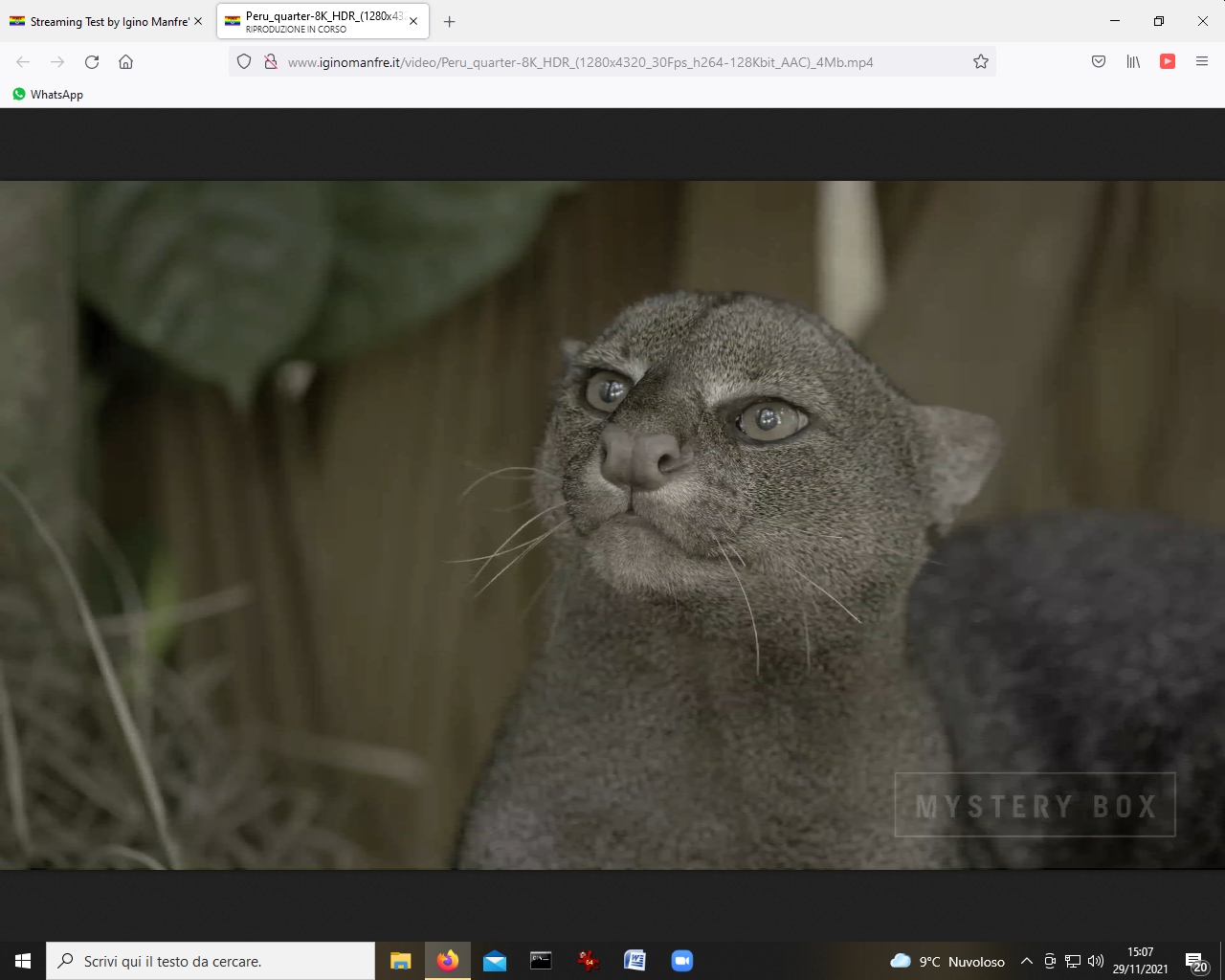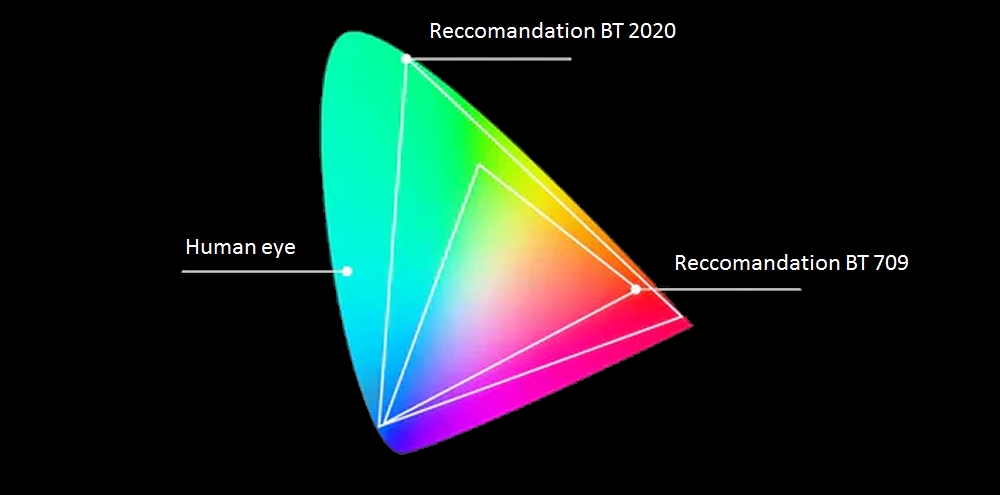Firefox uses Cisco's Open-h264 to decode l'h264.
Open-h264 support up to high profile, level 5.2 with the limit
of 36,864 macroblocks per frame (1 macroblock is a square of 16x16 pixels) and maximum format 4096x2160@60 frame per second with sample of 8 bit.
From this website I placed also the h265 version. It is useless to place it inline because it could not reproduced by the browser - try to recall with
VLC (or any suitable h265 UHD player) recalling http://iginomanfre.it/video/peru_01.mp4: it is a true 8k video
(7680x4320, 60 frame per second, with High Definition Range Chroma (reccomandation BT2020).
...but - by the above limitation - firefox can open on 64bit platform quarter-8k (1920x4320) with
Pixel Aspect Ratio 4:1. It fills an 8k frame with a trick: it is an almost-8k.
For more information about this space reduction technique, see approssimazione di LCEVC.
Firefox
utilizza l'Open-h264 di Cisco per decodificare l'h264 che
supporta
fino all'high profile, livello 5.2 con il limite di 36864 macroblocchi per frame (1 macroblocco e' un quadrato di 16x16 pixel) ed un formato massimodi 4096x2160 a 60 frame al secondo con campioni di 8 bit.
Da questo sito e' anche disponibile la versione h265. In ogni caso - è inutile metterlo in linea perché non potrebbe essere riprodotto dal browser - prova a richiamare
con
VLC (o qualsiasi lettore che riproduca l'h265 UHD) richiamando http://iginomanfre.it/video/peru_01.mp4:
è un vero video 8k
(7680x4320, 60 frame al secondo, in High Definition Range Chroma (reccomandation BT2020).
...ma - per la
limitazione di cui sopra - firefox può aprire su piattaforma a 64 bit quarter-8k (1920x4320) con
proporzioni pixel
4:1. Riempie un fotogramma da 8k con un trucco: è un quasi-8k.
Per altre informazioni su questa tecnica di riduzione spaziale vedi approssimazione di LCEVC.
In http://iginomanfre.it/video/peru_03.mp4 the original width of 7680 is divided by four obtaining a anamorphic framesize of 1920x4320 pixel
that returns - by the Pixel Aspect Ratio 4:1 - the original aspect ratio.
I call this format quarter-8k.
It has been encoded in h264 at 5 Mbps (high profile level 5.2, in HDR - reccomandation BT2020) at (a little) variable frame rate of about 60fps.
32bit firefox is unable to open this video (the video is not recognised with supported format or MIME type).
On 64bit platforms the software decoding of firefox is unable to play fluently even on an i7 octacore,
while VLC - on the same platforms - reproduce it smoothly.
So, this spatially reduced almost-8k (1920x4320, PAR 4:1) is on the boundary of what is usable
and what is not. I suggest to open it in full-screen and compare the following almost-8k and the 4k...
In http://iginomanfre.it/video/peru_03.mp4 l'ampiezza originale di 7680 e' stata divisa per quattro ottenendo un frame anamorfico di 1920x4320 pixel
che restituisce - grazie al Pixel Aspect Ratio 4:1 - l'aspect ratio originale di 16:9.
Ho denominato questo formato quarter-8k.
E' stato codificato in h264 a 5 Mbps (high profile, level 5.2, HDR - reccomandation BT2020) a frame rate (poco) variabile di circa 60fps.
Firefox a 32 bit non è in grado di aprire questo video (il video non e' riconosciuto con formato o MIME type supportato).
Sulle piattaforme a 64 bit il software di decodifica di firefox non è in grado di riprodurre in modo
fluido anche su un octacore i7,
mentre VLC - sulle stesse piattaforme - lo riproduce senza problemi.
Quindi, questo spazialmente ridotto quasi-8k (1920x4320, PAR 4:1) è al confine di ciò che è utilizzabile
e cosa no. Suggerisco di aprirlo a schermo intero e confrontare i seguenti quasi-8k e 4k sotto...

a screenshot of a quarter-8k recalled by Firefox on a 64 bit pc
http://iginomanfre.it/video/peru_04.mp4 is a quarter-8k too,
but with a constant frame rate of 30 frame al secondo, still in h264 HDR
32bit firefox is unable to open this video
(the video is not recognised with supported format or MIME type).
It is required a quite high computational power to play: at least an i5.
I suggest to open it in full-screen and compare the almost-8k with the 4k below...
http://iginomanfre.it/video/peru_04.mp4 e' anche un quarter-8k
ma a frame rate costante di 30 frame al secondo, sempre in h264 HDR
Firefox a 32 bit non è in grado di aprire questo video
(il video non e' riconosciuto con formato o MIME type supportato).
Per riprodurlo e' richiesta una potenza di calcolo abbastanza alta: almeno un i5.
Suggerisco di aprirlo in full-screen e di comparare questo quasi-8k con i 4k che seguono.

All colors visible to the average human eye are contained inside the diagram.
The two triangles are the Color Gamut of BT2020 and BT709 and represent all the
colors that can be represented in HDR video and normal television.
The Gamut of BT2020 is richer of green shadows.
The bottom "line of purples" is the locus of fully saturated colors that can be
only mixing two colors (red and blue).
Any segment between two points of the diagram define a subset of colors that can be
be obtained by mixing the colors at the end of the segment.
The three vertices of the triangle are Blue (lower left) Green (top) and Red (lower right).
The edge of the diagram, called the spectral locus, represent pure monochromatic
light measured by wavelength in nanometers. These are the most saturated colors.
On the contrary the least saturated colors are at the center, emanating from white.
There may be many whites, the most knows of which is the CIE 1931.
See the article
Demystifying High Dynamic Range (HDR) and Wide Color Gamut (WCG)
written by Alan Brown in 2018: it can be a primer through the argument.
Tutti i colori visibili all'occhio umano medio sono contenuti all'interno del diagramma.
I due triangoli sono la Color Gamut di BT2020 e BT709 e rappresentano tutte le
colori che possono
essere rappresentati nei video HDR e nella televisione normale.
La gamma di BT2020 è più ricca di ombre verdi.
La "linea dei viola" inferiore è il luogo dei colori
completamente saturi che possono essere
mescolando solo due colori (rosso e blu).
Qualsiasi segmento
tra due punti del diagramma definisce un sottoinsieme di colori che può essere
essere ottenuto mescolando
i colori alla fine del segmento.
I tre vertici del triangolo sono Blu (in basso a sinistra) Verde
(in alto) e Rosso (in basso a destra).
Il bordo del diagramma, chiamato locus spettrale, rappresenta
puro monocromatico
luce misurata dalla lunghezza d'onda in nanometri. Questi sono i colori più saturi.
Al centro, invece, sono i colori meno saturi, provenienti dal bianco.
Potrebbero esserci molti bianchi,
il più noto dei quali è il CIE 1931.
Consulta l'articolo
Demistificazione
dell'High Dynamic Range (HDR) e del Wide Color Gamut (Ampia Gamma Cromatica, WCG)
scritto da Alan Brown nel 2018:
può essere un primer attraverso l'argomento.
http://iginomanfre.it/video/peru_05.mp4 is a true 4k (3840x2160) HDR video,
encoded in h264 at 9 Mbps in high profile 5.2 level
at a framerate (slightly) variable around 60 fps
It is required a quite high computational power to play:
at least an i5, but being sofware only decompression, it could skip many frames.
I suggest to open it in full-screen and compare this 4k with the surrounding video.
http://iginomanfre.it/video/peru_05.mp4 è un vero video HDR 4k (3840x2160),
codificato in h264 a 9 Mbps in high profile, livello 5.2
ad un framerate (poco) variabile intorno ai 60 fps
Per la sua riproduzione è richiesta una potenza di calcolo piuttosto elevata:
almeno un i5, ma poiche' usa la sola decompressione software potrebbe saltare diversi frame.
Suggerisco di aprirlo in full-screen e di comparare questo 4k con i video circostanti.
http://iginomanfre.it/video/peru_09.mp4 is a more squeezed version (4Mbps)
of a true 4k video (3840x2160), at a slightly-variable framerate: around 60 fps
It is required a quite high computational power to play: at least an i5.
I suggest to open it in full-screen and compare this 4k with the surrounding video.
http://iginomanfre.it/video/peru_09.mp4" e' una versione piu' strizzata (4 Mbps)
di un vero 4k HDR (3840x2160) a framerate (leggermente) variabile attorno ai 60 fps
Per riprodurlo e' richiesta una potenza di calcolo abbastanza alta: almeno un i5.
Suggerisco di aprirlo in full-screen e di comparare questo 4k con i video circostanti.
http://iginomanfre.it/video/peru_10.mp4 is an half-4k (1920x2160) HDR compressed at 4 Mbps.
Here too it is encoded in slightly-variable framerate arount 60 fps
It is required a quite high computational power to play: at least an i5.
I suggest to open it in full-screen and compare this almost-4k with the surrounding video.
http://iginomanfre.it/video/peru_10.mp4 e' un half-4k (1920x2160) HDR compresso a 4 Mbps.
Anche qui e' codificato a framerate leggermente variable, intorno a 60 fps
Per riprodurlo e' richiesta una potenza di calcolo abbastanza alta: almeno un i5.
Suggerisco di aprirlo in full-screen e di comparare questo quasi-4k con i video circostanti.
I surrender me
Yesterday (December 2nd 2021) I was is a quite big electronic retail shop, and I asked to the assistant in front to an entire wall of flat screen display Is there any 8k screen?. He reply me almost immediately: no, they are all 4k, because no one broadcast in 8k.
It seems I'm not the only one that do not understand who need of 8k.
(excluding the willing to get more, more, more!)
On the web seems to understand that Windows and common browsers do not manages thing wider than 4k pixel
by 4K pixel (16 Mpixels)
After many attempt, I see that firefox, being based on cisco's open-264 do not handle video frames bigger
than 36864 macro-blocks
(see here)
up to profile/level high/5.2: it means that you cannot embed in a page a <video> tag with a video
(h264 or webm) bigger than 4k.
After crashing my head against the lack of browsers to handle h265 (there is nothing to do: since no
plug-in is available, they decode up to h264);
after trying to compress in many ways a video sequence squeezed in space (halving - or more - its width)
and time (reducing the framerate, with all but pleasant results);
after being obliged to use 64 bits handbrake (with great pleasure,
because the things that this software enable to do), because
avidemux filters do not
handle 8k video, i can resume the following things:
1) to decode (i.e. to reproduce) a video bigger than 4k compressed in h265 is required at least
a quadricore like (and above) intel i5
2) i'm going back to old h264 because I see that using a quarter-8k at 30 frame per
second, I'm able to produce an h264 6 Mbps video with HDR (BT2020) colorimetry that
flows in acceptable way on suitable pc or mobile phone with sufficient coputational power.
3) the smart-tv sold as 4k simply ignore any request of decoding bigger than 4k from any app that calls the
system hardware decoder.
But, more important, because I'm quite boried out to search workarounds to see almost inline h265.
The best at the moment is to use a transport stream (undecodicable from the browser)
that will invoke an external application (such as VLC, if correctly associated).
Mi arrendo
Ieri (2 dicembre 2021) ero in un negozio di elettronica piuttosto grande e ho chiesto all'assistente di fronte a un'intera parete di schermo piatto Ci sono 8k schermo?. Mi risponde quasi subito: no, sono tutti in 4k, perché nessuno trasmette in 8k.
Sembra che non sia l'unico a non capire chi ha bisogno dell'8k. (escluso il
desiderio di ottenere di più, di più, di più!)
Sul web sembra di capire che Windows e i browser comuni non gestiscono cose più
larghe di 4k pixel per 4K pixel (16 Mpixel)
Dopo molti tentativi, vedo che Firefox,
essendo basato su open-264 di Cisco, non gestisce fotogrammi video più grandi di 36864
macro-blocchi
(vedi qui)
fino al
profilo/livello high/5.2: significa che non puoi incorporare in una pagina un <video>
tag con un video (h264 o webm) non più grande di 4k (3840x2160).
Dopo essemi rotto la testa davanti alla incapacita' dei browser di gestire l'h265 (non c'e' nente
da fare: dal momento che i plug-in non vanno piu' di moda, decodificano al piu' l'h264);
dopo aver tentato di comprimere in vari modi una sequenza video ridotta spazialmente (dimezzando - o
piu' - la sua ampiezza ma impiegando un Pixel Aspect Ratio 2:1, 3:1 o 4:1) o nel tempo (riducendo il
framerate con risultati pessimi);
dopo essere stato costretto (con grande piacere, visto quello che permette di fare) ad utilizzare
handbrake
a 64 bit (perche' i filtri di avidemux
non
riescono a trattare l'8k),
si sono evidenziati i seguenti fatti:
1) per decodificare un video più grande di 4k compresso in h265 è necessario
almeno un quadricore come l'intel i5
2)e' il caso di tornare al vecchio h264 perché usando il third-8k a 30
frame per
secondo, sono in grado di produrre un video h264 a 6 Mbps con colorimetria
HDR (BT2020) che
scorre in modo accettabile su pc o cellulare con capacita' di calcolo sufficiente.
3) le smart-tv vendute come 4k semplicemente ignorano ogni richiesta di decodifica maggiore del 4k
da qualsiasi applicazione che utilizza il decodificatore hardware di sistema.
Ma soprattutto perche' sono abbastanza stanco di cercare di trovare delle soluzioni alternative per vedere
quasi in linea h265. La migliore e' utilizzare un transport stream (non decodificabile dal browser)
che richiamera' una applicazione esterna (come VLC, se correttamente associata).
The video heredown on the left is the original sequence (here embedded) I - once dowloaded from youtube -
I used for all the compression experiments;
The right video is a spatially reduced version that - with Pixel Aspect Ratio 4:1 - allow to obtain
a 8k. Yes, I know: it is a about a blamed HD, but it is one of my search of lost hope to see an
UHD video inline in a webpage. It is the video with jaguar shot in the opening picture.
Il video qui sotto a sinistra e' la sequenza originale (qui incorporata) che - una volta scaricata
da
youtube - ho usato per tutti le prove;
Il video a destra invece e' una versione ridotta spazialmente con con il Pixel Aspect Ratio 4:1 permette
di ottenere nuovamente un 8k. Si lo so: e' circa un volgare HD, ma fa parte della ricerca della
speranza perduta di vedere un UHD inline su una pagina web. E' il video con il giaguaro ripreso nella figura di apertura.
youtube original embedded
Original video by Jakob & Kate Schwarz embedded from Youtube
(link).
There is no constraints, because - despite the UHD label - Youtube,
using DASH, adapt the stream to the capability of your terminal
(pc, tv or smartphone) in a suitable way to be viewed
This source video is compressed in AV1
(computationally speaking a very heavy compression) at about 25 Mbps:
Only using downloading tools (such as Jdownloader2) is possible to download
the original full resolution and chroma format.
Video originale di Jakob & Kate Schwarz embeddato da Youtube
(link).
Non ci sono limitazioni, perche' - malgrado l'etichetta UHD - Youtube,
che utilizza il DASH, adatta lo stream alle capacita' del tuo terminale
(pc, tv o smartphone) in modo da poter essere visto.
Il video sorgente e' compresso in AV1
(molto pesante in termini computazionali) a circa 25 Mbps:
Solo utilizzando un tool di download (come JDownloader2) e' possibile scaricare
la dimensione ed il formato originale.




